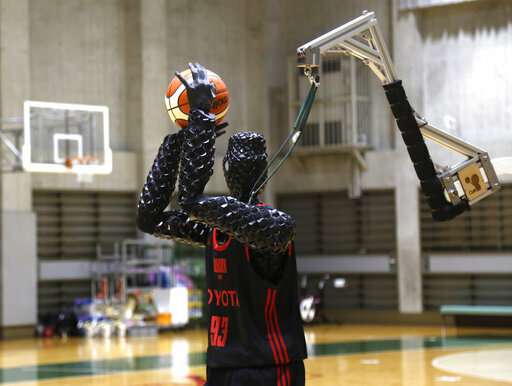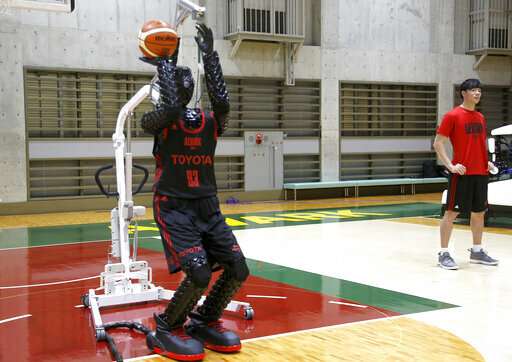Toyota's basketball robot Cue 3 demonstrates Monday, April 1, 2019 at a gymnasium in Fuchu, Tokyo. The 207-centimeter (six-foot-10) -tall machine made five of eight three-pointer shots in a demonstration in a Tokyo suburb Monday, a ratio its engineers say is worse than usual. Toyota Motor Corp.'s robot, called Cue 3, computes as a three-dimensional image where the basket is, using sensors on its torso, and adjusts motors inside its arm and knees to give the shot the right angle and propulsion for a swish.(AP Photo/Yuri Kageyama)
It can't dribble, let alone slam dunk, yet Toyota's basketball robot hardly ever misses a free throw or 3-pointer.
The 207-centimeter (six-foot, 10-inch) tall machine made 5 of 8 3-point shots in a demonstration in a Tokyo suburb Monday, a ratio its engineers say is worse than usual.
Toyota Motor Corp.'s robot, called Cue 3, computes as a three-dimensional image where the basket is, using sensors on its torso, and adjusts motors inside its arm and knees to give the shot the right angle and propulsion for a swish.
Efforts in developing human-shaped robots underline a global shift in robotics use from pre-programmed mechanical arms in limited places like factories to functioning in the real world with people.
The 2017 version of the robot was designed to make free throws.
Toyota's basketball robot Cue 3 demonstrates Monday, April 1, 2019 at a gymnasium in Fuchu, Tokyo. The 207-centimeter (six-foot-10) -tall machine made five of eight three-pointer shots in a demonstration in a Tokyo suburb Monday, a ratio its engineers say is worse than usual. Toyota Motor Corp.'s robot, called Cue 3, computes as a three-dimensional image where the basket is, using sensors on its torso, and adjusts motors inside its arm and knees to give the shot the right angle and propulsion for a swish.(AP Photo/Yuri Kageyama)
© 2019 The Associated Press. All rights reserved.

























